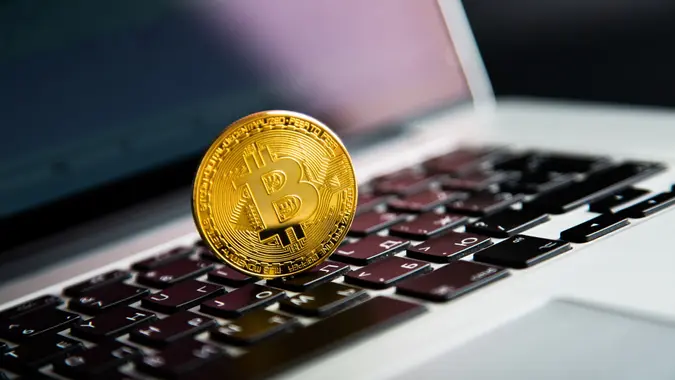What Is Tokenization and How Does It Work?

Commitment to Our Readers
GOBankingRates' editorial team is committed to bringing you unbiased reviews and information. We use data-driven methodologies to evaluate financial products and services - our reviews and ratings are not influenced by advertisers. You can read more about our editorial guidelines and our products and services review methodology.

20 Years
Helping You Live Richer

Reviewed
by Experts

Trusted by
Millions of Readers
As blockchain technology becomes more popular, tokenization is commonly used to secure the ownership of assets, protect data and participate in crypto investing. However, while many users understand what a crypto token is, they may struggle with the concept of tokenization and how it is used.
What Is Tokenization?
Tokenization is the process of converting an asset or the ownership rights of an asset to a unique unit called tokens. Tokens are commonly referred to when discussing blockchain technology, where they are used to indicate the ownership of a valuable asset.
Tokens can indicate ownership of tangible assets, like art, or they can indicate ownership of intangible assets, such as shares in a company or voting rights. Tokenization can occur for any item that is deemed valuable.
Tokens can then be used to transfer ownership of an asset, make payments and complete other financial tasks. An example of tokenization would be Bitcoin. It is a popular cryptocurrency that uses tokens to represent how much BTC a person owns.
Tokenization began as a type of data security for businesses that replaces sensitive information with unique, non-sensitive data. Tokens don’t contain the original data, but they usually share similar characters or formatting.
A user would need access to the tokens that are connected to the separately-stored originals in order to restore the tokens and view the secured data. Otherwise, a user would not be able to decipher the token to view the data. Therefore, they can be useful for securing personal information, financial transaction data and other sensitive data.
How Does Tokenization Work?
Tokens simply act as substitutes for real information or assets. They have no inherent use or value other than to secure data. Tokens can be created in multiple ways using techniques like reversible cryptographic functions, nonreversible functions or randomly-generated numbers.
Tokens are connected to transaction information that is stored on a decentralized ledger known as the blockchain. This secures the ownership of an asset since the transactions can be confirmed using blockchain data.
When tokenization is used to protect payment information, the seller will use a payment gateway that generally automates the token creation process and stores the original data elsewhere. The token is sent to a payment processor, which can be connected back to the original information in the seller’s token vault.
Types of Tokenization
There are multiple types of blockchain tokenization and non-blockchain tokenization.
Blockchain Tokenization
Types of blockchain tokenization include:
- Fungible tokenization. These are standard blockchain tokens. They have identical values, so they can easily replace one another — think of swapping one dollar for another dollar.
- Non-fungible tokenization. These are less common blockchain tokens that do not have a set value. Instead, they represent ownership of an asset, such as digital art or real estate, that determines the value of the token.
- Governance tokenization. These tokens represent voting rights and can be used to vote and collaborate on a blockchain system.
- Utility tokenization. These tokens are used to give access to certain products and services on a specific blockchain, so they can be used to complete actions like paying transaction fees or operating a decentralized market system.
Non-blockchain Tokenization
Types of non-blockchain tokenization include:
- Vault tokenization. This is the standard type of tokenization to protect payment information, where the token is used to process payments without providing card numbers or other data.
- Vaultless tokenization. This is a type of tokenization used for payment processing that doesn’t require a token vault for storage. Instead, it uses cryptographic devices and algorithms to convert data to a token.
- Natural language processing tokenization. This type of tokenization breaks information down into simpler terms to make it more easily understood by computers. It includes word, sub word and character tokenization.
While tokenization began with the idea of protecting data assets using non-blockchain tokenization, it has developed into a way to protect the ownership of many other types of assets by using blockchain technology.
Benefits of Tokenization
Tokenization can improve liquidity, make financial transactions more convenient and help secure ownership rights.
Since tokens are not traded on a traditional investment market, users can avoid a lot of the process that is involved in investing in traditional securities or buying large assets. For example, buying a token that represents ownership of real estate is a much faster process than buying non-tokenized property.
The ability to cut out parts of the process can help decrease the overall cost of investing in these assets and save time. In addition, tokens are available to a much larger audience, including those who may not have access to expensive investments. Therefore, the market can become more liquid, and users can have more investment opportunities.
The blockchain technology is used to store transaction data and also helps to secure the history of a token. For example, if someone wanted to dispute the ownership of a token, the blockchain would have a record of all transactions associated with a token and be able to verify ownership.
Non-blockchain tokenization also has its benefits for businesses and organizations that need to protect customer or member data. Customers will feel more secure knowing that their identity is being protected, and tokenization helps companies meet regulations set by the PCI SSC.
Final Take
Tokenization has helped secure business data over the years, and now it is expanding the ability to trade ownership of assets all over the world. However, there are still many obstacles that are hindering tokenization from reaching its full potential as a form of investing.
Technology and investing regulations vary in each country, which makes it difficult to create seamless transactions. Governments are beginning to shift regulations, and people are learning more about the use of tokens, which is helping the technology grow and become recognized as a powerful financial tool.
Those who are interested in investing but come up against barriers in the traditional market may be able to find new investment opportunities that use tokenization to digitize the value of assets. For example, investors who are starting with less capital may consider exploring cryptocurrency or tokenized real estate.
Regardless of which direction investors choose, they should always evaluate any investment option thoroughly before jumping in.
Information is accurate as of Aug. 31, 2022.
Our in-house research team and on-site financial experts work together to create content that’s accurate, impartial, and up to date. We fact-check every single statistic, quote and fact using trusted primary resources to make sure the information we provide is correct. You can learn more about GOBankingRates’ processes and standards in our editorial policy.
- Binance Academy. 2022. "What Are Governance Tokens?"
- RSI Security. 2022. "HOW TO MEET TOKENIZATION PCI DSS REQUIREMENTS."
- Adyen. "Tokenization payment technology guide."
- Forbes. 2022. "What Investors Should Know About Tokenization."
- ACM Digital Library. 2022. "SoK: Tokenization on Blockchain."
- SoluLab. "Vaultless Tokenization vs. Vault Tokenization."
- Tokenex. 2022. "What is NLP (Natural Language Processing) Tokenization?"
 Written by
Written by  Edited by
Edited by 

























